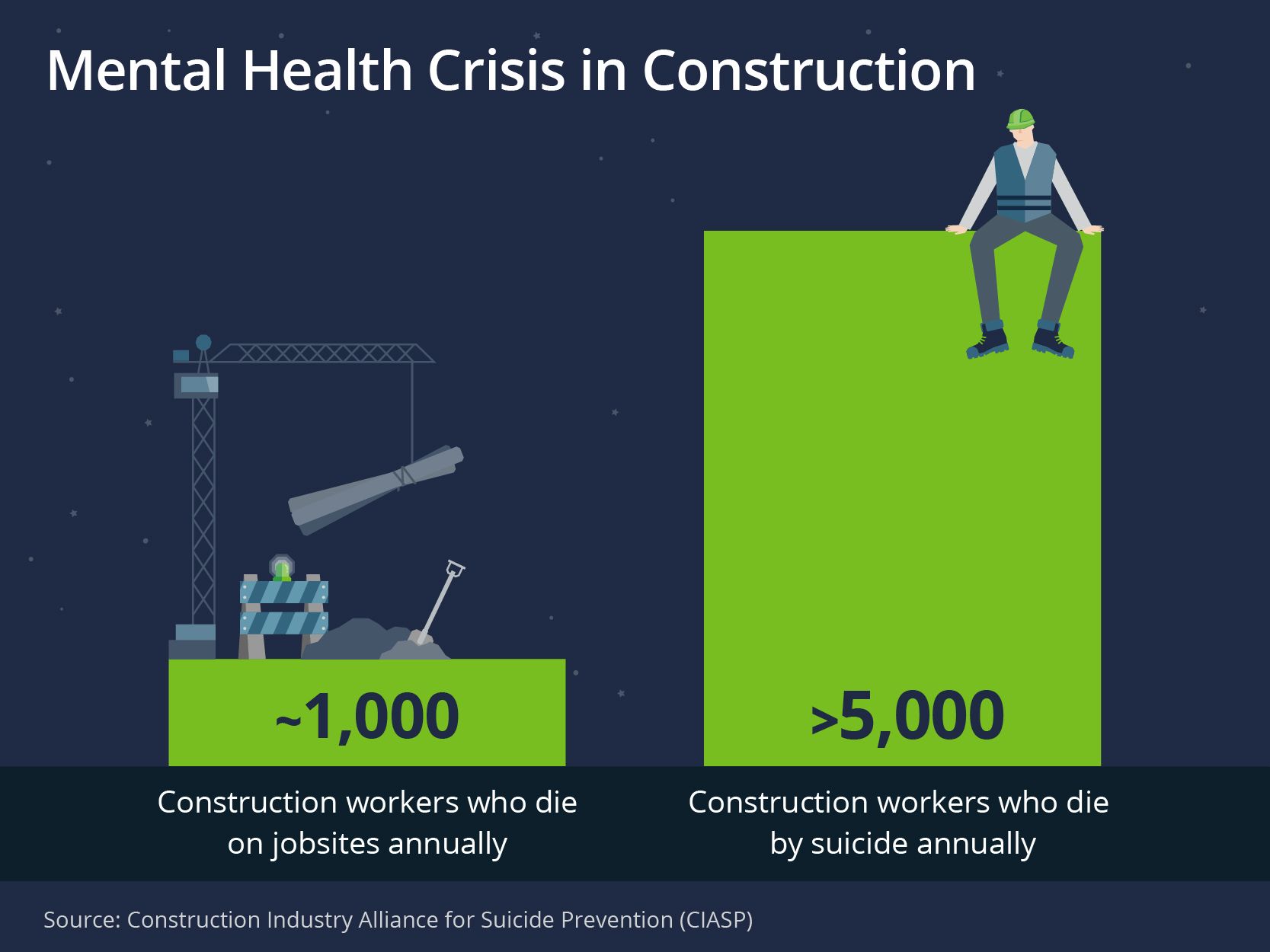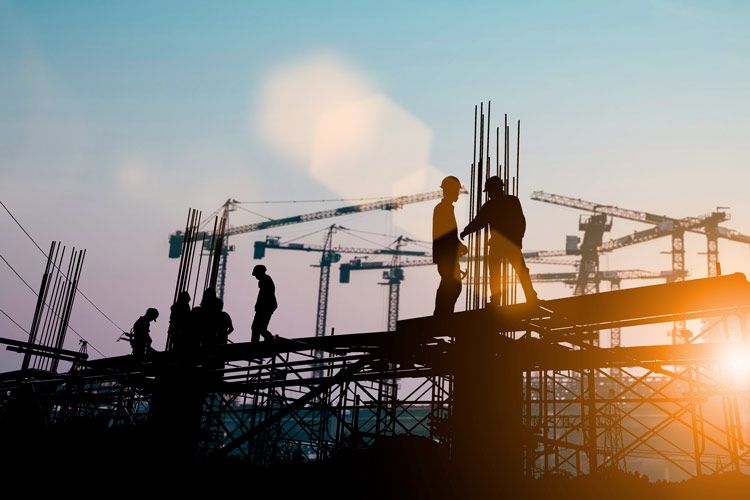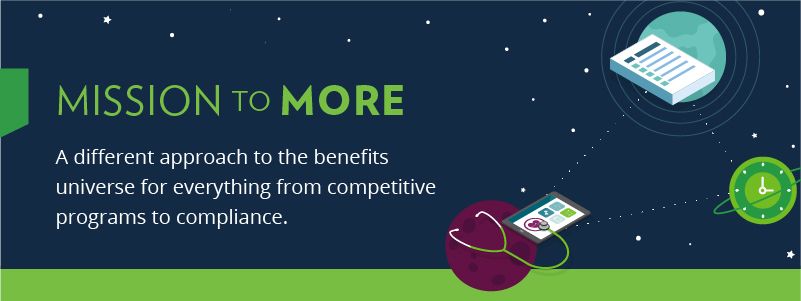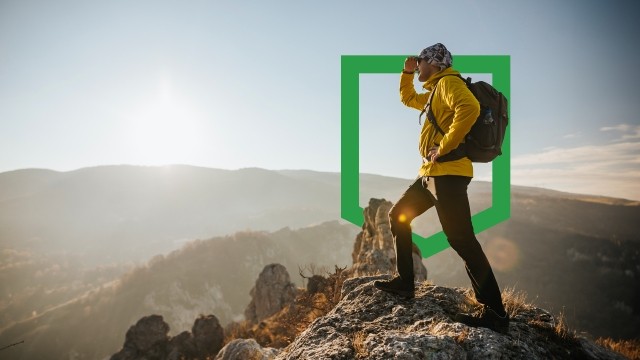Blog
An Industry at Risk: Addressing Mental Health in Construction
Get practical steps you can take as a leader to help improve or even save your employees’ lives.
| This article discusses suicide and mental health. If you or someone you know is experiencing thoughts of suicide, don’t wait to get help. Call or text the National Suicide Prevention Lifeline at 988 or text HELLO to 741741 for free, 24/7, confidential support. |
Construction occupations have the highest rates of death by suicide1 and drug overdose2 in the United States, and it’s increasing. It’s no secret that construction is a tough industry, built by hard-working laborers who put in long hours under tight deadlines in all kinds of working conditions, often while dealing with physical pain and injury. Topics like mental health and wellness aren’t normally a part of workplace conversations in a culture deeply ingrained with the ideals of picking yourself up by your bootstraps.
Now more than ever, there is a critical need for companies to understand and respond to mental health in construction. We’ll cover practical steps you can take as a leader to help improve or even save your employees’ lives.
| At-a-Glance Read time: 6 minutes |
||
|---|---|---|
What’s Behind the Mental Health Crisis in Construction?
Although hard hats are common on jobsites, what happens under them isn’t a normal topic of discussion for many safety managers.
According to the Construction Industry Alliance for Suicide Prevention (CIASP), approximately 1,000 construction workers die on jobsites each year, and over 5,000 people working in construction die by suicide each year. There are many factors that contribute to this mental health crisis.

- Difficult and varying working conditions. Construction workers are often in environments where they may face physical strain, seasonal layoffs, severe weather conditions, and long periods away from friends and family. Moving from jobsite to jobsite can create an environment in which workers are not as connected to their families, friends, or a workplace community, often resulting in strains on relationships. In addition, working long or irregular hours can impact sleep patterns, causing sleep deprivation that adds to mental and physical exhaustion.
- Unhealthy habits as a coping mechanism. Many workers develop bad habits to cope with these issues, like using drugs, alcohol, or opioids. Not only does this contribute to the risk of accidental overdose, but alcohol and opioid use disorders increase the risk of suicidal ideations, attempts, and deaths.
- A hardened culture. The pressure of appearing to have tough skin and just suck it up when difficulties arise leads to not sharing issues for fear of appearing weak. This applies both physically and mentally, leading to overall burnout.
Finding Solutions for Your Employees
While there’s no PPE for mental health, there are ways companies can help. There is no single cure for the mental health crisis in the construction industry but using a multi-prong approach to address mental health can help increase your program’s effectiveness.
Start Talking
Create a safe culture by spreading awareness and reducing stigma around conversations about addiction, mental health, and suicide. Find what works best for your employees and their personalities to help them make connections with their team.
Here are some ideas to consider:
- Conduct focus groups of 10–15 people, selecting those who represent critical groups within the company, to discuss mental health issues. They can also help develop ideas to build awareness of the different challenges employees face.
- Perform interviews with all key stakeholders, including company leaders, HR directors, safety directors, and foremen to assess needs, strengths, and readiness or resistance to wellness programs.
Taking time to listen to employees will increase the likelihood of higher buy-in when you are ready to take the next steps of implementation.
Offer Addiction Support
The nature of construction jobs, like performing repetitive physical tasks, can contribute to substance abuse. Some workers use alcohol, opioids, and other drugs to handle the physical pain they endure, and many workers head to a bar after work to relax and socialize. However, these habits can lead to addiction.
Here are some steps to take:
- Create an environment that allows those struggling with addiction to ask for and be directed to professional help.
- Offer training to management and supervisors on how to identify the signs of substance abuse so they can recognize coworkers who may need help and refer them to resources.
- Be upfront about your drug testing program. Explain that it is designed to protect everyone from danger.
- Host alcohol-free events such as group volunteer activities, fantasy sports leagues, and family picnics.
- Develop a substance abuse prevention program. You can find resources and information at drugfreeconstruction.org.

Create a Wellness Program
Mental health benefits haven’t traditionally been widely adopted in the construction industry, but it’s clear there is a need. The good news is there are many ways you can provide resources that fit your team.
- Provide mental health training for managers and supervisors. This group is your front line to observe and connect with direct labor employees, helping to refer them to qualified resources. Programs like Mental Health First Aid offer training courses similar to CPR certification classes.
- Ensure mental health services are easy to access and are the right fit for your team. While many construction workers may shy away from one-on-one help, they may respond to group therapy with their peers like Sesh or virtual mental health coaching resources like Headspace. There are many platforms that are easy to access online, eliminating the need to go to a provider’s office and offering more flexibility in scheduling.
- Review working environments and include mental health awareness in regular safety management reviews.
- Set up crisis support through an employee assistance program (EAP) or crisis management team that focuses on grief and trauma support. Companies like Concern can come in as needed for critical incident briefing.
Resources for EmployersA growing number of mental health resources are geared toward the construction industry to help you navigate wellness programs. |
Make Wellness a Priority in Construction
Being a good steward toward your employees is more than just a moral decision—it’s also a wise business decision. Workers who are physically and mentally healthy perform better on the job and have fewer accidents compared to those who are experiencing mental health struggles. In an American Psychological Association survey from April 2023, 20% of respondents said stress led to lower productivity; it can also directly and indirectly affect employee safety. In addition, US workers who rate their mental health as fair or poor report about four times more unplanned absences than their counterparts who had better mental health, according to Gallup.
You wouldn’t send your team to a job without the right tools. Giving them resources to better manage their wellness, both physically and mentally, sets them up for success both on and off the jobsite. Protecting your people protects your business. A forward-thinking benefits consultant can help you assess the available benefit options that offer the most impact for your employees.
Our Mission to More series offers guidance from leading specialists on what employees want and how employers can adapt to the new benefits universe. For more guidance on trends and emerging benefits solutions, sign up for Woodruff Sawyer’s Benefits newsletter, which includes all Mission to More articles.
1Cora Peterson, Ph.D., Aaron Sussell, Ph.D., Jia Li, MS, Pamela K. Schumacher, Kristin Yeoman, MD, Deborah M. Stone, Sc.D. "Suicide Rates by Industry and Occupation — National Violent Death Reporting System, 32 States" Center for Disease Control and Prevention (2016)
2 Rachael M. Billock, Ph.D., Andrea L. Steege, Ph.D., and Arialdi Miniño, M.P.H., "Drug Overdose Mortality by Usual Occupation and Industry: 46 U.S. States and New York City," Division of Vital Statistics (2020)
Author
Table of Contents













